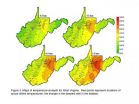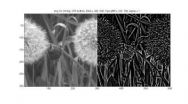(Press-News.org) A balloon angioplasty device that sucks up dangerous plaque debris could trigger a "paradigm shift" in how physicians treat peripheral artery disease, researchers write in the current issue of Endovascular Today.
"We will see a shift in how we treat lesions," write Dr. Robert Dieter of Loyola University Health System and Dr. Aravinda Nanjundappa of West Virginia University.
In two clinical trials totaling 123 patients, the device had a success rate of 97 percent to 99 percent and consistently outperformed filter devices typically used to capture debris particles, Dieter and Nanjundappa write.
The Food and Drug Administration has approved the device, Proteus®, made by Angioslide, for angioplasties that treat peripheral artery disease (PAD) in the legs. PAD is caused by clogged arteries that restrict blood flow to the legs. Symptoms include painful cramping in the hips, thighs or calves when walking, climbing stairs or exercising. Advanced PAD can cause gangrene or even lead to limb loss.
A balloon angioplasty is among the standard treatments for PAD. A physician inserts a catheter in an artery and guides it to the blockage, then opens the artery by inflating a balloon at the tip of the catheter. The physician typically deploys a stent to keep the artery open.
Inflating the balloon can knock loose particles of plaque, which travel down the leg. A large particle can block blood flow, a condition called distal embolization. In the most severe cases, distal embolizations can require leg amputation or even be fatal.
Until now, some physicians have used a filter device to prevent debris from escaping. However, the filter can damage the artery, and can be difficult to deploy. Moreover the FDA has not approved filter devices for use in leg arteries. Using filters for PAD procedures, although routine, must be done "off label."
The new device that Dieter used opens the artery just like a standard angioplasty balloon. After the artery is opened, the physician deflates the balloon. The negative pressure sucks up the debris, which is trapped inside as the balloon retracts.
"This is a much more simple and elegant approach than filter devices," said Dieter, an interventional cardiologist and vascular specialist.
Dieter is an assistant professor in the Department of Medicine, Division of Cardiology at Loyola University Chicago Stritch School of Medicine and Director of Vascular Medicine and Peripheral Vascular Interventions at Edward Hines VA Hospital. Dieter has used the device on patients at Loyola and Hines.
His first Loyola patient was Patricia Durkin of Oak Forest, Il. Before the procedure, the top of the iliac artery that supplies blood to her left leg was 90 percent blocked. "If I walked in the mall, I had to stop every few minutes," she said. "It made my leg feel heavy. It got to the point where I didn't want to walk any distance."
The procedure restored normal blood flow. "I don't have that heavy feeling anymore," Durkin said.
Other interventional cardiologists at Loyola also plan to use the device, said Dr. John Lopez, director of Interventional Cardiology Research and professor in the Department of Medicine, Division of Cardiology.
"At Loyola, interventional cardiology is very progressive, and at the forefront of technology for the treatment of PAD," Lopez said.
INFORMATION: END
GRAND RAPIDS, MICH., Oct. 5, 2010 – Only about a third of American women are meeting their fruit and vegetable intake recommendations, which means they are likely missing out on potentially important breast and ovarian health benefits (1). Along with vitamins, minerals and fiber, fruits and vegetables contain a type of phytonutrient called carotenoids, which research suggests help support women's health including breast and ovarian health.
Based on a new report called America's Phytonutrient Report: Women's Health by Color, older women have total carotenoid intakes ...
OAK RIDGE, Tenn., Oct. 5, 2010 -- By installing wireless sensors and replacing faulty traps along the 12 miles of steam lines at Oak Ridge National Laboratory, officials expect to save as much as $675,000 per year.
With 1,600 steam traps, which normally open slightly to discharge condensed steam with a negligible loss of live steam, the problem occurs when a trap fails and that failure goes undetected and unrepaired, said Teja Kuruganti, a member of the Computational Sciences and Engineering Division.
Manual inspections of each trap is a daunting and sometimes dangerous ...
DALLAS (SMU) – New research produced by Southern Methodist University's Geothermal Laboratory, funded by a grant from Google.org, suggests that the temperature of the Earth beneath the state of West Virginia is significantly higher than previously estimated and capable of supporting commercial baseload geothermal energy production.
Geothermal energy is the use of the Earth's heat to produce heat and electricity. "Geothermal is an extremely reliable form of energy, and it generates power 24/7, which makes it a baseload source like coal or nuclear," said David Blackwell, ...
Under the Water Framework Directive (WFD) (Directive 2000/60/CE), member states are required to achieve Good Water Status for water (continental, estuarine, subterranean and coastal water bodies) in Europe by 2015. Surface water quality is assessed taking into account the ecological and chemical status.
The quality of aquatic systems is more accurately assessed using the status of both the water column and the underlying sediment. A recent study by researchers of AZTI-Tecnalia concluded that water bodies risk being misclassified if, on evaluating their chemical status, ...
Researchers at the Georgia Institute of Technology have developed a new "templated growth" technique for fabricating nanometer-scale graphene devices. The method addresses what had been a significant obstacle to the use of this promising material in future generations of high-performance electronic devices.
The technique involves etching patterns into the silicon carbide surfaces on which epitaxial graphene is grown. The patterns serve as templates directing the growth of graphene structures, allowing the formation of nanoribbons of specific widths without the use of ...
CHAMPAIGN, Ill. — Wind power is likely to play a large role in the future of sustainable, clean energy, but wide-scale adoption has remained elusive. Now, researchers have found wind farms' effects on local temperatures and proposed strategies for mediating those effects, increasing the potential to expand wind farms to a utility-scale energy resource.
Led by University of Illinois professor of atmospheric sciences Somnath Baidya Roy, the research team will publish its findings in the Proceedings of the National Academy of Sciences. The paper will appear in the journal's ...
PHILADELPHIA –- Physicists and neuroscientists from the University of Pennsylvania have linked the cell structure of the retina to the light and dark contrasts of the natural world, demonstrating the likelihood that the neural pathways humans use for seeing are adapted to best capture the world around us.
Researchers found that retinal ganglion cells that see darkness are more numerous and cluster closer together than those that see light, corresponding to the fact that the natural world contains more dark spots than light. Now physicists, and not just pessimists, ...
Phishing scams are making the leap from email to the world's voice systems, and a team of researchers in the Georgia Tech College of Computing has found a way to tag fraudulent calls with a digital "fingerprint" that will help separate legitimate calls from phone scams.
Voice phishing (or "vishing") has become much more prevalent with the advent of cellular and voice IP (VoIP) networks, which enable criminals both to route calls through multiple networks to avoid detection and to fake caller ID information. However each network through which a call is routed leaves its ...
DENVER (October 5, 2010) - With over 500 million users worldwide, Facebook has become a global phenomenon, a vast cyber neighborhood where friends meet to share photos, news and gossip.
But when those relationships sour, another phenomenon often occurs – unfriending.
In what may be the first comprehensive study of its kind, a University of Colorado Denver Business School student has revealed the top reasons for Facebook unfriending, who is unfriended and how they react to being unfriended.
"Researchers spend a lot of time examining how people form friendships online ...
Optical gyroscopes, also known as rotation sensors, are widely used as a navigational tool in vehicles from ships to airplanes, measuring the rotation rates of a vehicle on three axes to evaluate its exact position and orientation. Prof. Koby Scheuer of Tel Aviv University's School of Physical Engineering is now scaling down this crucial sensing technology for use in smartphones, medical equipment and more futuristic technologies.
Working in collaboration with Israel's Department of Defense, Prof. Scheuer and his team of researchers have developed nano-sized optical gyroscopes ...

